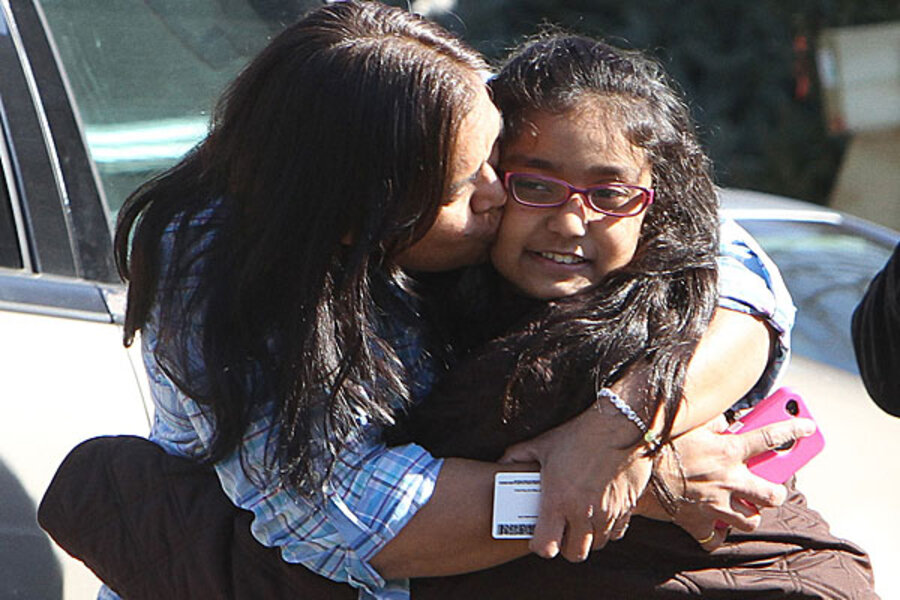School shooting in Connecticut casts somber mood across nation
Loading...
The rampage inside a Newtown, Conn., elementary school Friday, killing 27 people, including 20 children, marks the deadliest and most shocking primary-school shooting in recent US history.
Eyewitnesses said they heard at least 100 shots before police reported to an atrocious shooting scene at Sandy Hook Elementary. Among the dead, according to news reports, were the school principal and a school psychologist who had rushed into a hallway when they heard gun pops.
Scenes of police searching local woods only added to a sense of confusion, tragedy, and dread after a span of months where the nation has been jolted again and again as gunmen have entered public spaces and opened fire.
Just this week, a young man opened fire at a packed Oregon mall, killing two people. In July, another young man is accused of opening fire at a midnight showing of a "Batman" film in Aurora, Colo., killing 12 and injuring 58.
"My heart is in a million pieces right now," one Sandy Hook mom told CNN, summing up a somber mood across the nation.
President Obama, wiping away tears, said at the White House, "Each time I learn news like this I react not as a president, but as anybody else would, as a parent, and that's especially true today." He added, "As a country we have been through this too many times – an elementary school in Newtown, a shopping mall in Oregon, a temple in Wisconsin, a movie theater in Aurora, a street corner in Chicago. These are our neighborhoods, these children are our children. We have to come together and take meaningful action to prevent more tragedies like this, no matter the politics."
Indeed, the shooting is likely to throw new focus on post-Columbine school security measures, as well as the knotty issue of gun control. Just this year, the principal of Sandy Hook Elementary had sent a letter to parents informing them of a new security protocol. It included staff viewing visitors through a camera before buzzing them in, while parents who weren't familiar to staff would have to show picture IDs.
"With nearly 700 students and over 1,000 parents, most parents will be asked for a picture ID," the principal, Dawn Hochsprung, wrote.
In the past few weeks, some have speculated that major gun-control legislation could be raised in a second term by Mr. Obama, who up until now has been hesitant to tackle the issue amid numerous major court decisions that support Americans' constitutional right to bear arms for self-defense.
But an attack on innocent children in a quiet, New England town that one resident called "the safest place in America" instantly reignited the gun-control debate. White House spokesman Jay Carney made an initial response to that debate.
"It's important on a day like today to ... feel enormous sympathy for families that are affected and to do everything we can to support state and local law enforcement and support those who are enduring what appears to be a very tragic event," he said. "There is, I'm sure, will be, rather, a day for discussion of the usual Washington policy debates, but I don't think today is that day."
Among school shootings in the United States, only the 2007 Virginia Tech massacre, where 32 people died, took a greater toll. Since the 1999 Columbine shootings, where 12 students and one teacher died, the deadliest school shooting came in 2005 on the Red Lake Indian Reservation in northern Minnesota, where a troubled student killed four classmates, four adults, and then himself. Also, in 2006, five girls were killed at an Amish school, West Nickel Mines School, Pennsylvania.
The deadliest school incident in US history took place in Bath Township in Michigan in 1927, when an enraged school-board treasurer set off three bombs that killed 44 people, including 38 schoolchildren as young as 7, before killing himself with a car bomb.
Some news outlets were reporting that the gunman was in his 20s and that his mother was a teacher at the school. She was apparently killed, as well as some of her students. More than one weapon, including a .223-caliber rifle, was recovered at the scene, according to media reports. The gunman was apparently found dead in a classroom, but it wasn't clear if his death was self-inflicted. Another fatality connected to the rampage was also reported at another location.







